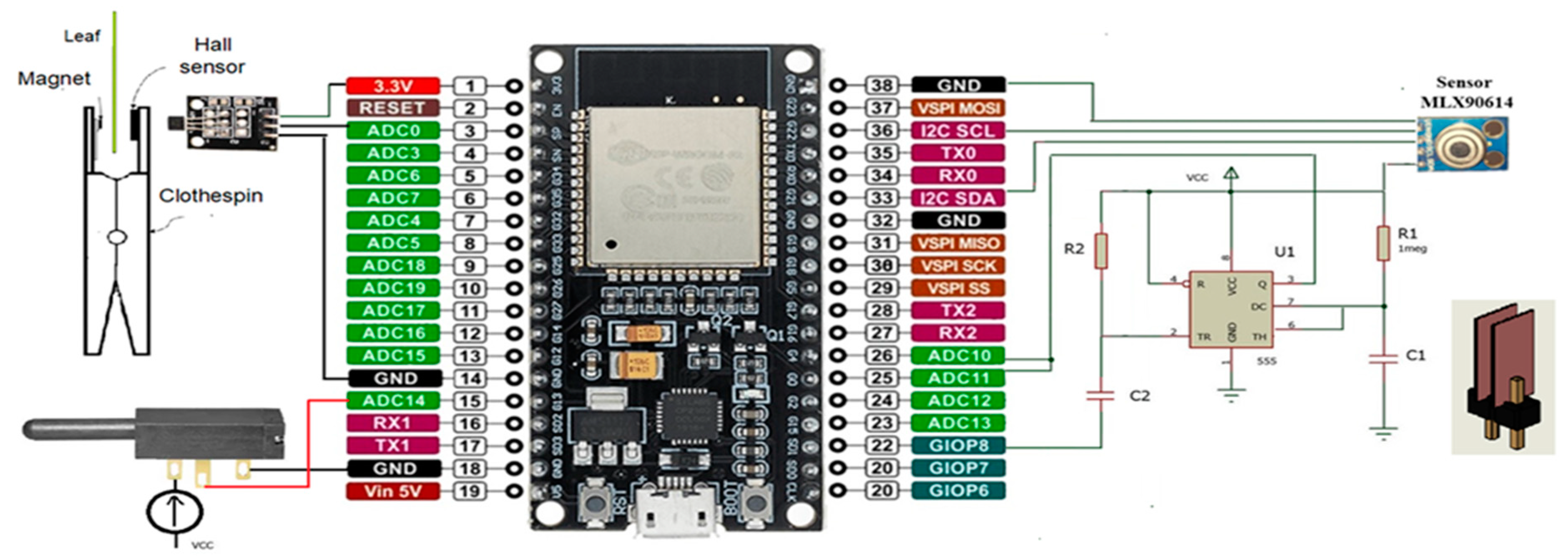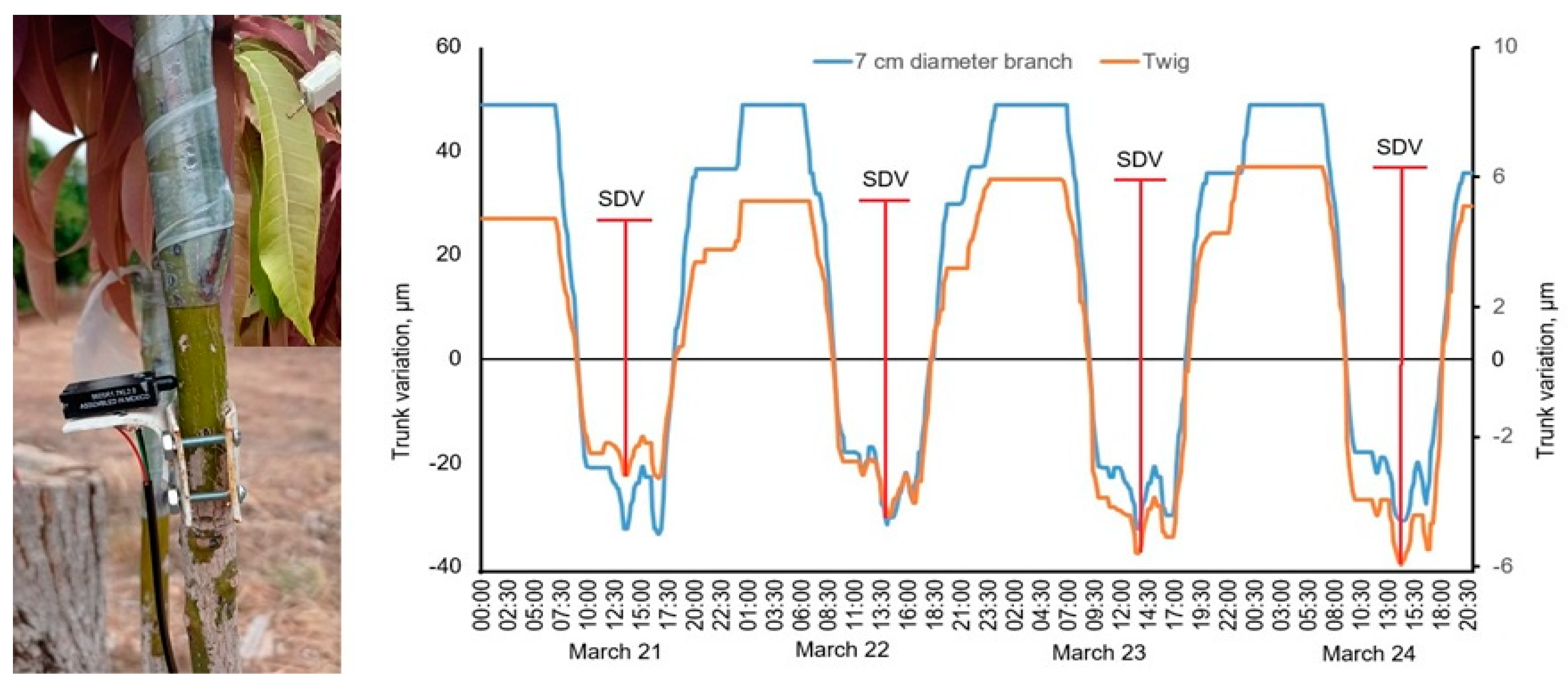1. Introduction
The amount of water available for irrigation is limited and mango trees require a large quantity during flowering and fruit growth. Pests and diseases in fruit trees will be present after a water shortage [
1]. Different irrigation scheduling methods can be used, being ideal if the plant water status is known [
2]. Plant water status monitoring relies on the leaf or stem water status or stomatal conductance. Sap flow, trunk diameter and leaf turgor pressure are some of the variables studied in fruit and forest trees [
2]. The near infrared region (NIR) spectral reflectance of leaves is positively correlated to leaf thickness. Leaf tissues with variable water content present different NIR reflectance signatures at 760 nm, 970 nm and 1450 nm [
3]. This technique is becoming useful in cameras transported by unmanned aerial vehicles (UAV) [
4]. In trees, stem daily variations (SDV) change from tenths to hundreds of microns depending on stem diameter. Dendrometers measure trunk variations using linear variable differential transformers (LVDT), linear resistors and strain gauges. Stem diameter increases or shrinks daily due to soil water availability and atmospheric demand. For scheduling irrigation, maximum daily shrinkage (MDS) and stem growth rate (SGR) are the best indicators. For young trees, SGR is a better indicator than MDS, as the latter could be more affected by growth than by water stress [
5]. Both stem and branch indicators are successfully used to control irrigation but are still expensive for growers [
6].
Leaf turgor has a significant effect on stomatal behavior and can be used to study leaf water content. A magnetic leaf patch-clamp pressure probe (ZIM) is used to obtain leaf turgor measurements [
7]. This probe does not work well when leaves suffer from dehydration, as vapor accumulates in the leaf tissues and the pressure chip does not sense properly [
4]. Capacitive sensors are used in precision agriculture to estimate leaf moisture content as their dielectric constant change [
8].
Three sensors were developed to monitor mango tree water status in the tree trunk and tree leaves. In a twig of a mango tree, the sensors were evaluated during a season. Capacitance leaf meters are easy to install, and their use and operation was analyzed.
2. Equipment Design
The monitoring equipment makes use of dendrometers to measure trunk variations, leaf capacitance sensors and a sensor to measure magnetic field changes through the day. The dendrometer measures the axial variations (thickness) of the trunk or branch during the day. An ESP32-WROOM-32 microcontroller board (Espressif, Shanghai, China) controls the dendrometer by using a linear resistor (model 9605R1.7KL2.0, BEISensors, Thousand Oaks, CA, USA) to provide an analog output voltage according to the trunk diameter. A current source avoids output voltage fluctuations when battery voltage discharges. The TTGO-ESP32-WROOM-32 card has a Bluetooth module for wireless transmission of data to a cell phone.
A simple capacitance meter uses 2-cooper parallel plates with the mango leaf between them being the dielectric constant; the plates were pushed from the outside by two Teflon washers. The capacitor plates are 15 mm long and 4 mm wide. A 555 timer was configured as a monostable multivibrator (
Figure 1). The pin 22 of the ESP32 applies a trigger pulse to the input terminal (2) of the 555. A pulse at output (3) changes its state from low (0) to high (VCC). The capacitor charges exponentially and when it reaches 2/3 VCC, the output returns to low (0), representing the end of the pulse. The pulse duration (T) corresponds to the value determined by:
The output (3) of the 555 is connected to pins 25 and 26 of the ESP32 which are programmed as interrupts 0 and 1. ESP32-pin 25 linked to interrupt 0 detects the rising edge of the output pulse and instantly will stop any activity taking place. In this moment, the ESP32 will act as a counter. When the 555 output pulse ends, interrupt 1 (ESP32-pin 26) will detect its falling edge. The counter will stop, and its value will represent the RC charging period given by Equation (1). If the resistance is known, the capacitor can be calculated. These pulses will be read ten times and the average capacitance will be saved in the mass storage device (MSD). Every 10 min the capacitance will be studied.
Leaf temperature was monitored throughout the day with a remote infrared temperature sensor (MLX90614, Melexis, Nashua, NH, USA) fixed 5 cm over the leaf. Communication takes place through the I2C bus, making it easy to read, and several sensors can be connected. It was connected to pins 36 and 33 of ESP32 (
Figure 1).
The Hall effect module (mod KY-035, Keyes, Hamilton, ON, Canada) is a magnetic field sensor, that provides an analog voltage output according to the field strength. The sensor has a plate where an electric current circulates. When a magnetic field interacts, the electrons are displaced generating a potential difference. A high gain amplifier generates an output voltage proportional to the intensity of the magnetic field. The Hall effect sensor is attached to one side of a clamp and a 200-gauss magnet is hold by the other side (
Figure 1). The leaf remains between the magnet and the sensor and is not pressed by them. The distance between the Hall sensor and the magnet was of 5 mm for magnetic field monitoring.
3. Field Measurements
Field experiment was conducted during the 2019-2021 period in a high-density commercial mango farm at Loma Bonita (17°25′47″ N, −101°11′19″ W, 17 m ASL), in the state of Guerrero, Mexico. The trial site is characterized by basaltic clay-loam red soil, being its average bulk density of 1.1 g cm−3. A 0.15 m deep circular furrow was dug to retain water beneath the trees canopy.
Measurements were taken with the dendrometer during the entire season in 7 cm diameter branches of 20-year-old trees. Ten trees older than 30 years were selected in 2021 and cut down with a chainsaw and watered to begin the rejuvenation process. The grafts were prepared, shaved, and attached to the vegetative shoots before being tightly covered with plastic to prevent moisture from entering (
Figure 2).
Dendrometer installation requires the dissection of a tree branch in order to fix the linear resistance (
Figure 2). The encapsulated capacitive sensor was placed close to the 555 timer on the upper leaves. The sensor that measures the magnetic variations was also placed on a leaf at the top of the canopy. If the magnet and the Hall sensor were placed in the same clamp to press the leaf, noise in the measurements was appreciated when amplification was 12 and sampling period was 20 s. A simple EMA (exponential moving average) filter reduces sampling noise. The sampling time was carried out every minute and the filter α used a constant of 0.2 to optimize the measurements.
4. Results and Discussion
Dendrometer stem daily variations (SDV) are constant for the 7 cm diameter branch (
Figure 2). This blue line varies from a maximum value of 49 µm at midnight to −30 µm at midday. In the twig, continuous SDV growth is noted over the four days, both noted at midnight and midday. SDV was 7.5 on 21 March 2021 and increased daily to achieve 12.2 on 24 March 2021. Vegetative twigs irrigated daily showed an SDV increase of 62.6%.
The capacitance sensor was first tested by introducing a dry coffee paper filter and then watered. Capacitance values were 5.61 and 4.51 pF, respectively, meanwhile air capacitance is 4.44 pF. Leaf capacitance monitoring during a cloudy and windless day is shown in
Figure 3a. An increase in capacitance starts at 13:30 and peaks at 15:30 as shown with the red square, showing a similar behavior as encountered by Afzal [
8]. A good relationship during the day is observed between temperature and capacitance. On the third day, water was applied, and capacitance decreased. The capacitance of wet leaves was higher than dry leaves (
Table 1). EMA low pass filter used an α = 0.2, a sampling time of 20 s, and a Hall sensor resolution of 10. Experiments showed that the Hall effect sensor measurements are related to plant water status and its temperature. Under controlled conditions, measurements were significantly better, obtaining a quasi-constant line when the plant was not watered. Hall sensor measurements decreased when temperature increased (
Figure 3b).
Author Contributions
Conceptualization, F.H., J.E. and U.Z.; writing—original draft preparation, F.H., J.E. and U.Z.; writing—review and editing, U.Z.; supervision, F.H. All authors have read and agreed to the published version of the manuscript.
Funding
This research was funded by the University Autonoma Chapingo, grant number 20014-DTT-65.
Data Availability Statement
Data were obtained by farmers and can be obtained from Dr. Hahn.
Conflicts of Interest
The authors declare no conflict of interest.
References
- Osroosh, Y.; Peters, R.T.; Campbell, C.S.; Zhang, Q. Comparison of Irrigation Automation Algorithms for Drip-Irrigated Apple Trees. Comput. Electron. Agric. 2016, 128, 87–99. [Google Scholar] [CrossRef] [Green Version]
- Fernández, J.E. Plant-based sensing to monitor water stress: Applicability to commercial orchards. Agric. Water Manag. 2014, 142, 99–109. [Google Scholar] [CrossRef] [Green Version]
- Nicolai, B.M.; Beullens, K.; Bobelyn, E.; Peirs, A.; Saeys, W.; Theron, K.I.; Lammertyn, J. Non-destructive measurement of fruit and vegetable quality by means of NIR spectroscopy: A review. Postharvest Biol. Technol. 2007, 46, 99–118. [Google Scholar] [CrossRef]
- Fernández, J.E. Plant-Based Methods for Irrigation Scheduling of Woody Crops. Horticulturae 2017, 3, 35. [Google Scholar] [CrossRef] [Green Version]
- Nortes, P.A.; Pérez-Pastor, A.; Egea, G.; Conejero, W.; Domingo, R. Comparison of changes in stem diameter and water potential values for detecting water stress in young almond trees. Agric. Water Manag. 2005, 77, 296–307. [Google Scholar] [CrossRef]
- Lu, P. Mango water relations and irrigation scheduling. In Proceedings of the 1st International Conference on Mango and Date Palm: Culture and Export, Faisalabad, Pakistan, 20–23 June 2005. [Google Scholar]
- Zimmermann, D.; Reuss, R.; Westhoff, M.; Gessner, P.; Bauer, W.; Bamberg, E.; Bentrup, F.W.; Zimmermann, U. A novel, non-invasive, online monitoring, versatile and easy plant-based probe for measuring leaf water status. J. Exp. Bot. 2008, 59, 3157–3167. [Google Scholar] [CrossRef] [PubMed] [Green Version]
- Afzal, A.; Duiker, S.W.; Watson, J.E.; Luthe, D. Leaf thickness and electrical capacitance as measures of plant water status. Am. Soc. Agric. Biol. Eng. 2017, 60, 1063–1074. [Google Scholar] [CrossRef]
| Publisher’s Note: MDPI stays neutral with regard to jurisdictional claims in published maps and institutional affiliations. |
© 2021 by the authors. Licensee MDPI, Basel, Switzerland. This article is an open access article distributed under the terms and conditions of the Creative Commons Attribution (CC BY) license (https://creativecommons.org/licenses/by/4.0/).








